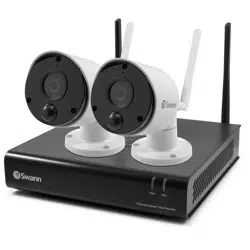Loading ...
Loading ...
Loading ...

Click for contents
68
Glossary
Compound Stream: Indicates that your DVR or NVR is recording video and
audio at the same time.
Contrast: This increases the difference between the blackest black and the
whitest white in the image. Without contrast you wouldn’t have an image be-
cause there wouldn’t be any differentiation between light and dark.
Covert: The camera will detect motion and trigger your DVR or NVR to re-
cord, but you will not see an image of the camera in Live View mode.
DDNS (Dynamic DNS): Is a service that converts IP addresses into host names
(a host name is a lot easier than trying to remember an IP address). It also
supports dynamic IP addresses, such as those assigned by a DHCP server.
This makes DDNS a good fit for home networks, which normally receives an
IP address from the ISP that will change occasionally.
DHCP (Dynamic Host Configuration Protocol): Uses an appropriate server
or router to enable dynamic assignment of an IP address to a device connect-
ed to the network.
Display Resolution: Is the number of pixels supported by your TV or VGA
monitor or the output signal of a viewing device, e.g. your DVR or NVR.
DNS Server: Is a standard technology for managing public names of web
sites and other internet domains. DNS technology allows you to type names
into your web browser which your computer will automatically find the ad-
dress on the internet.
DST (Daylight Saving Time): Is the period of the year when clocks are moved
one hour ahead.
DualStream: A process where your DVR or NVR will record both Mainstream
and Substream video at the same time.
Format: Is a command that prepares a storage device such as a USB flash
drive or hard drive to hold data.
Firmware: The software that operates a discrete device (e.g. your smart-
phone). It is referred to in this way rather than software as it is integral to the
operation of the device.
Frame Rate: The measurement of the rate that pictures are displayed to cre-
ate a video feed. The unit of measurement is frames per second (fps).
Gateway: Is a node or router that routes traffic from a device on your home
network to the outside network that is providing access to the internet.
H.264+: Mass video data requires increased storage capacity. To resolve this
issue, video compression technologies are used to reduce the data while
maintaining image quality. H.264+ is an innovative encoding technology
aimed at surveillance video.
H.265: Is a video compression standard and one of several potential succes-
sors to the widely used H.264. It offers double the data compression ratio at
the same level of video quality.
Hardware: A physical device such as your DVR or NVR.
HDD (Hard Disk Drive): Is a storage device located inside your DVR or NVR. It
is where all data is kept, saved and stored.
HTTP Port (Hypertext Transfer Protocol): This port is used to log into the
web browser interface of your DVR or NVR (if available) using a web client,
such as Internet Explorer.
Hue: Is somewhat synonymous to what is usually referred to as colors. By
altering the hue, you can change the color mix of the image.
IP Address: The address of a device attached to the network. Each device on
the network must use a unique address.
Loading ...
Loading ...
Loading ...
